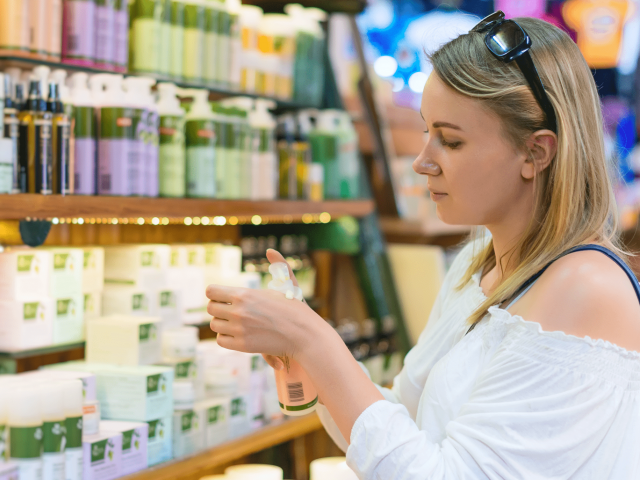
"Natural" and homemade cosmetics and cleaning products aren't by definition safer than mainstream products. EWG takes a closer look at two common plant-based ingredients - tea tree and lavender oils - and finds that the science is still evolving and safety can't be assumed. First of a two-part blog on health concerns tied to natural ingredients.
All natural.
Plant-based.
Petroleum-free.
You've no doubt seen buzzwords like these splashed across cosmetics and cleaning supply labels, but what exactly do they mean?
Truth is, customers tend to trust these front-of-the-package claims and often don't know that some household cleaners and common cosmetics contain chemicals tied to health problems such as asthma, allergies, hormone disruption and even cancer. Other consumers are more aware of the potential health effects of toxic ingredients and are actively looking for apparently safer products, while still others are taking it a step further and making their own cosmetics and cleaning supplies - with ingredients they buy individually - so they can be sure that what's in them is safe.
Examine Natural Products, Too
While these alternatives may seem better - and even offer a sense of control in the face of misleading advertising claims and confusing and toxic ingredients - it's still important to ask: Is a homemade or naturally-derived product necessarily safer? Maybe, maybe not, is the unsatisfying answer. Unfortunately, safety standards are nearly non-existent when it comes to ingredients in cleaning supplies and cosmetics, including natural ones.
Take tea tree and lavender oils, for example. They are two natural ingredients common in both cosmetics and cleaning agents. When I took a close look at the ones I have at home, nearly half contained one or the other. Both compounds have many uses and benefits, but researchers have raised concerns about potential health effects from excessive exposure to each. We'll explore tea tree oil here - stay tuned for our follow up blog post on lavender oil tomorrow.
Here's what we know:
Tea Tree Oil
Over the past several years, use of tea tree oil has been on the rise, spurred by scientific studies showing that the compound can kill microbes such as flu viruses, E. coli and antibiotic-resistant Staphylococcus aureus (MRSA) bacteria, mold, mildew and other types of fungus.
However, just as for synthetic antibacterials, overuse of naturally derived antibacterial compounds can eventually render them ineffective. Numerous studies all over the world show that using antibacterial soap at home is no more effective at eliminating germs or preventing the spread of infection than ordinary soap, but it has a real potential downside: breeding resistant bacteria. Bacteria adapt readily to changing environments and can easily evolve into new strains that no longer respond to antibiotics or other antibacterials when they are overused.
So what about tea tree oil? A study published by Irish scientists in 2007 found that bacteria exposed to tea tree oil became resistant to it. Even more worrisome, they also became more resistant to conventional antibiotics. Researchers concluded that while tea tree oil is indeed an effective antibacterial agent, low-level, sustained application "may contribute to the development of antibiotic resistance in human pathogens" - a significant and growing medical concern.
Tea tree oil is often used in aromatherapy and massage therapy, where it is inhaled or applied directly to the skin. A recent study of air quality in spas in China found that tea tree oil generated the highest levels of an important class of indoor air contaminants (secondary organic aerosols) compared to other essential oils. Should a day at the spa automatically come with an extra dose of air pollution? And how might these air contaminants affect spa workers exposed daily?
Applying tea tree oil in massage oils and lotions raises concerns about skin allergies. Several studies show that it can cause skin irritation and allergies (often referred to as contact dermatitis or skin sensitization). In a 2008 report, the European Commission's Scientific Committee on Consumer Products (SCCP) concluded that tea tree oil could induce both skin and eye allergies. Another study found 41 dermatitis cases out of 2,320 people tested and linked 41 percent of them to tea tree oil. The European Cosmetic Toiletry and Perfumery Association (COLIPA) recommends that products with this ingredient be formulated with extreme care:
"Tea Tree Oil should not be used in cosmetic products in a way that results in a concentration greater than 1% oil being applied to the body. When formulating Tea Tree Oil in a cosmetic product, companies should consider that the sensitization potential increases if certain constituents of the oil become oxidized. To reduce the formation of these oxidation products, manufacturers should consider the use of antioxidants and/or specific packaging to minimize exposure to light."
Based on this research, EWG does not suggest avoiding all products containing tea tree oil, but it is wise to respect this potent compound and use it with caution - and with all the information you can get.
Watch for the second part of EWG's two-part blog for information on lavender oil and take-home tips for both oils.
[A big thanks to flickr CC and jaybergesen for the beautiful lavender field pic.]



